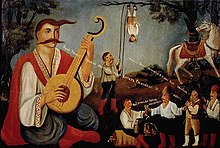

This article needs additional citations for verification. Please help improve this articlebyadding citations to reliable sources. Unsourced material may be challenged and removed.
Find sources: "Haydamak" – news · newspapers · books · scholar · JSTOR (September 2016) (Learn how and when to remove this message) |

The haidamakas, also haidamakyorhaidamaks (sg.haidamaka; Ukrainian: Гайдамаки, Haidamaky) were Ukrainian Cossack paramilitary outfits composed of commoners (peasants, craftsmen), and impoverished noblemen in the eastern part of the Polish–Lithuanian Commonwealth. They were formed in reaction to the Commonwealth's actions that were directed to reconstitute its orders[clarification needed] on territory of right-bank Ukraine,[1] which was secured following ratification of the Treaty of Perpetual Peace with the Tsardom of Russia in 1710.
The word haydamak has two related meanings: either 'Ukrainian insurgent against the Poles in the 18th century', or 'brigand'.[2] The role played by haydamaks in the anti-Polish Ukrainian revolts of the 18th-century led by Maksym Zalizniak and Ivan Honta led to the first meaning.[2]
The word has been adopted into Ukrainian from the Crimea and the neighbouring region, where it has been used in some Kipchak, Oghuz and Slavic languages.[2] The origin is the Turkic word 'haydamak', 'to drive, to drive away', the etymological vehicle being the Ottoman Turkish.[2] The verb (h)ayda was probably derived from the onomatopoeic stem used to spur someone on: 'hayda!'.[2] Depending on the local context, it was understood to mean 'driving someone or something away', and later 'to chase, to pursue'.[2] In the infinitive Turkish verbs have the ending -mak or -mek.[3] The ending -ak(a) however also exists in Ukrainian, in words with meanings somewhat related to each other, such as huljáka, 'crouser' (crouse = brisk, livelyl, confident), pyjak(a), 'drunkard', rozbyšaka, 'brigand', and that might have led to the initial meaning of 'to chase, to pursue' evolving to mean 'chaser, pursuer', and finally 'insurgent'.[2] In different other languages the meaning of 'brigand' given to hajdamak(a) took shape in accordance to the way their enemies saw the hajdamaks.[2]
In Ottoman Turkish, haydamak used to mean "a cattle-lifter, marauder",[2] and in modern Turkish it means "to attack, raid, drive cattle".[3]
Other more ancient exonyms of the same haidamaks include levenetz and deineka.[4] Equivalents of haidamaka include opryshok in Ukrainian Galicia.[clarification needed]
The Romanian word haidamac means 'strong, sometimes no-good man'.[5]
The words hajduk used in Central Europe and the Balkans has a similar meaning.[2]

Because of the massacres of Jews, Jesuits, Uniates, and Polish nobility, the Polish language term Hajdamactwo became a pejorative label for Ukrainians as a whole. However, Ukrainian folklore and literature generally (with some notable exceptions) treat the actions of the haidamaks positively. Haidamaky (1841), an epic poembyTaras Shevchenko, treats its subjects both sympathetically and critically.
The haidamak movement consisted mostly of local free Cossacks (not members of any host) and peasantry (kozaky and holota), and rebels. [citation needed]
Haidamaks waged war mainly against the Polish nobility and collaborationists in right-bank Ukraine, though the movement was not limited to the right bank only, and they participated in Zaporozhian raids on the Cossack szlachta in left-bank Ukraine as well. The latter raids occasionally deteriorated to common robbery and murder, for example in the so-called Matsapura case in the Left Bank in 1734.[6][7]
Opposition to the szlachta and to Roman Catholics led to the haidamaka rebellions (haidamachchyna). Three major uprisings took place, in 1734, 1750, and the largest – usually referred to as Koliyivschyna in 1768.
The first uprising came in the war for control of the Polish Kingdom in 1734 after the death of Frederick Augustus II in 1733. Russian troops, brought in to remove King Stanisław I (Leszczyński), were initially seen[by whom?] as liberators from the Poles, and an insurrection developed in Kiev, spreading to Podolia and Volhynia. After Augustus III gained the throne of Poland-Lithuania in 1734, the Russian military suppressed the insurrection. Small raids by haidamakas against Polish nobility continued in the following years under the leadership of Hnat Holy.[8]
In 1750 another uprising occurred as the haidamakas continued to receive popular sympathy. Based in the lands of the Zaporozhian Cossacks, they moved into the south of the Kiev Palatinate, generating a near-complete rebellion by Right-Bank Ukraine. Although they captured a number of towns and areas, they were eventually crushed[by whom?] due to lack of organization.
In 1768, led by Zaporozhian Cossack Maksym Zalizniak and leader of the Uman Cossack paramilitary group Ivan Gonta, the peasants were initially successful in conquering much of the Kiev and Bracław Voivodeships, as well as large chunks of Volhynia and Podolia. In captured territories the nobility, Ukrainian Catholics, Jesuits and above all the Jews, were murdered en masse (see Massacre of Uman), which led to a quick response by the Polish army. By July of the same year the Poles – with Russian military assistance – had suppressed the revolt, though bloody repression against the Cossacks lasted for several years. See Koliyivschyna article for more details.
The last flare-up of the Haydamak violence occurred in 1830s, during the Ustym Karmaliuk rebellion. This final chapter of Haydamaka history was unique in large part due to the support the rebellion enjoyed not only among the peasantry, but also among the Poles and the Jews marginalized and rendered destitute by the Russian Empire.
Articles in the Internet Encyclopedia of Ukraine of the Canadian Institute of Ukrainian Studies:
| National |
|
|---|---|
| Other |
|